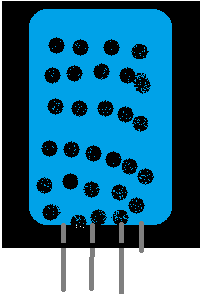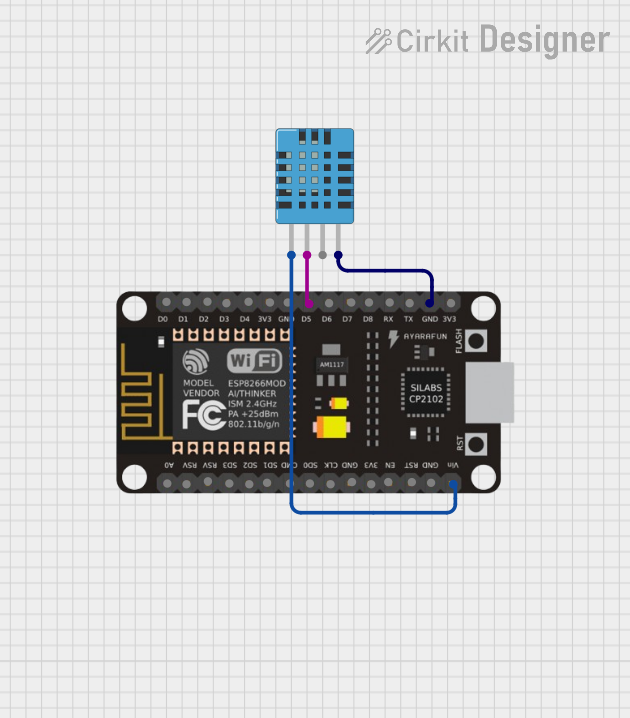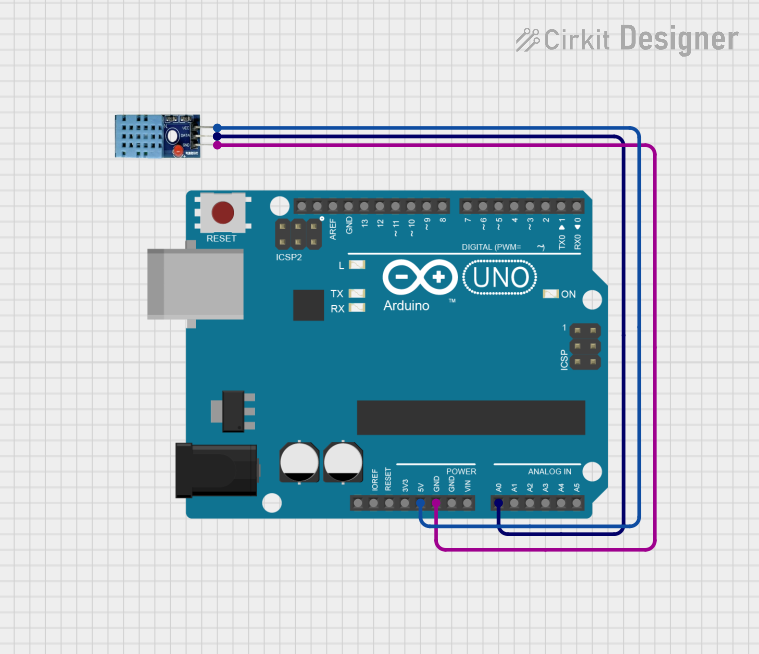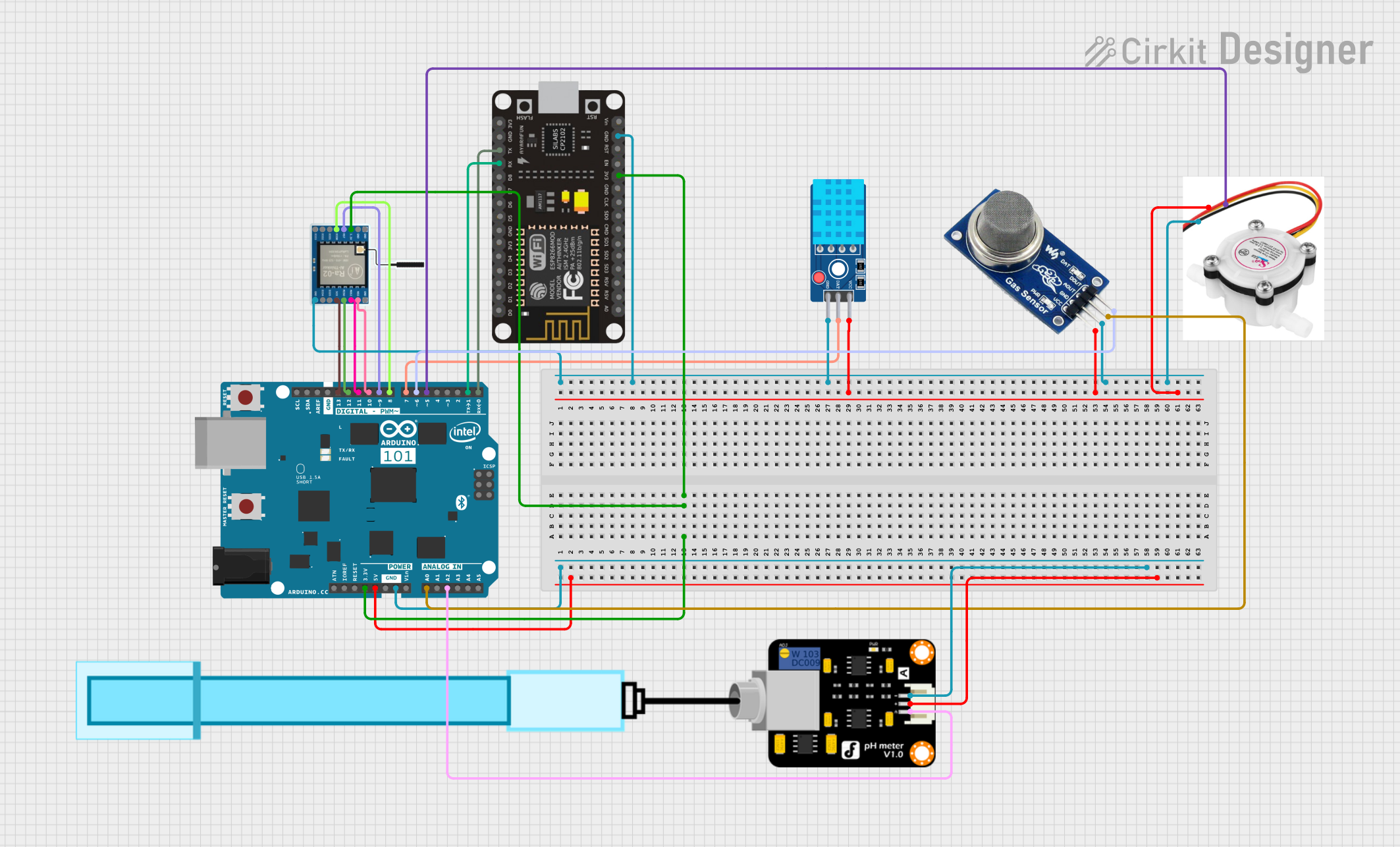
How to Use dht11: Examples, Pinouts, and Specs

 Design with dht11 in Cirkit Designer
Design with dht11 in Cirkit DesignerIntroduction
The DHT11 is a digital temperature and humidity sensor that provides accurate readings of environmental conditions. It features a single-wire digital interface, making it easy to connect to microcontrollers for data collection. The DHT11 is widely used in applications such as weather monitoring, home automation, and industrial control systems due to its simplicity and reliability.
Explore Projects Built with dht11

 Open Project in Cirkit Designer
Open Project in Cirkit Designer
 Open Project in Cirkit Designer
Open Project in Cirkit Designer
 Open Project in Cirkit Designer
Open Project in Cirkit Designer
 Open Project in Cirkit Designer
Open Project in Cirkit DesignerExplore Projects Built with dht11

 Open Project in Cirkit Designer
Open Project in Cirkit Designer
 Open Project in Cirkit Designer
Open Project in Cirkit Designer
 Open Project in Cirkit Designer
Open Project in Cirkit Designer
 Open Project in Cirkit Designer
Open Project in Cirkit DesignerCommon Applications:
- Weather stations
- HVAC systems
- Greenhouse monitoring
- IoT devices
- Home automation systems
Technical Specifications
The DHT11 sensor is designed for basic temperature and humidity sensing applications. Below are its key technical details:
Key Specifications:
- Temperature Range: 0°C to 50°C (±2°C accuracy)
- Humidity Range: 20% to 90% RH (±5% accuracy)
- Operating Voltage: 3.3V to 5.5V
- Max Current Consumption: 2.5mA
- Communication Protocol: Single-wire digital interface
- Sampling Rate: 1 Hz (1 reading per second)
- Dimensions: 15.5mm x 12mm x 5.5mm
Pin Configuration:
The DHT11 sensor has four pins, but typically only three are used in most applications. Below is the pinout:
| Pin Number | Name | Description |
|---|---|---|
| 1 | VCC | Power supply (3.3V to 5.5V) |
| 2 | DATA | Digital data output (connect to microcontroller) |
| 3 | NC (Not Connected) | No connection (leave unconnected) |
| 4 | GND | Ground |
Usage Instructions
The DHT11 sensor is easy to use with microcontrollers like the Arduino UNO. Follow the steps below to integrate it into your project:
Wiring the DHT11:
- Connect the VCC pin of the DHT11 to the 5V pin on the Arduino.
- Connect the GND pin of the DHT11 to the GND pin on the Arduino.
- Connect the DATA pin of the DHT11 to a digital I/O pin on the Arduino (e.g., pin 2).
- Place a 10kΩ pull-up resistor between the DATA pin and the VCC pin to ensure stable communication.
Arduino Code Example:
Below is an example of how to read temperature and humidity data from the DHT11 using an Arduino UNO. This code uses the popular DHT library.
// Include the DHT library
#include <DHT.h>
// Define the DHT sensor type and the pin it's connected to
#define DHTPIN 2 // Pin connected to the DATA pin of DHT11
#define DHTTYPE DHT11 // Specify the sensor type (DHT11)
// Initialize the DHT sensor
DHT dht(DHTPIN, DHTTYPE);
void setup() {
Serial.begin(9600); // Start serial communication
Serial.println("DHT11 Sensor Initialization");
dht.begin(); // Initialize the DHT sensor
}
void loop() {
// Read temperature and humidity values
float humidity = dht.readHumidity();
float temperature = dht.readTemperature();
// Check if the readings are valid
if (isnan(humidity) || isnan(temperature)) {
Serial.println("Failed to read from DHT sensor!");
return;
}
// Print the readings to the Serial Monitor
Serial.print("Humidity: ");
Serial.print(humidity);
Serial.print(" %\t");
Serial.print("Temperature: ");
Serial.print(temperature);
Serial.println(" °C");
delay(2000); // Wait 2 seconds before the next reading
}
Best Practices:
- Use a pull-up resistor (10kΩ) on the DATA pin to ensure reliable communication.
- Avoid placing the sensor in direct sunlight or near heat sources for accurate readings.
- Allow the sensor to stabilize for a few seconds after powering it on before taking readings.
- Ensure the sampling rate does not exceed 1 Hz (1 reading per second).
Troubleshooting and FAQs
Common Issues:
No Data or Incorrect Readings:
- Cause: Loose connections or missing pull-up resistor.
- Solution: Check all connections and ensure a 10kΩ pull-up resistor is used on the DATA pin.
"Failed to read from DHT sensor!" Error:
- Cause: Sensor not properly initialized or incorrect wiring.
- Solution: Verify the wiring and ensure the correct pin is defined in the code.
Inconsistent Readings:
- Cause: Environmental interference or unstable power supply.
- Solution: Place the sensor away from interference sources and use a decoupling capacitor (e.g., 0.1µF) across the power pins.
FAQs:
Q: Can the DHT11 measure negative temperatures?
A: No, the DHT11 can only measure temperatures in the range of 0°C to 50°C.
Q: Can I use the DHT11 with a 3.3V microcontroller?
A: Yes, the DHT11 operates within a voltage range of 3.3V to 5.5V.
Q: How do I extend the cable length for the DHT11?
A: Use shielded cables and keep the length under 20 meters to avoid signal degradation.
Q: What is the difference between the DHT11 and DHT22?
A: The DHT22 offers a wider temperature and humidity range with higher accuracy, but it is more expensive than the DHT11.